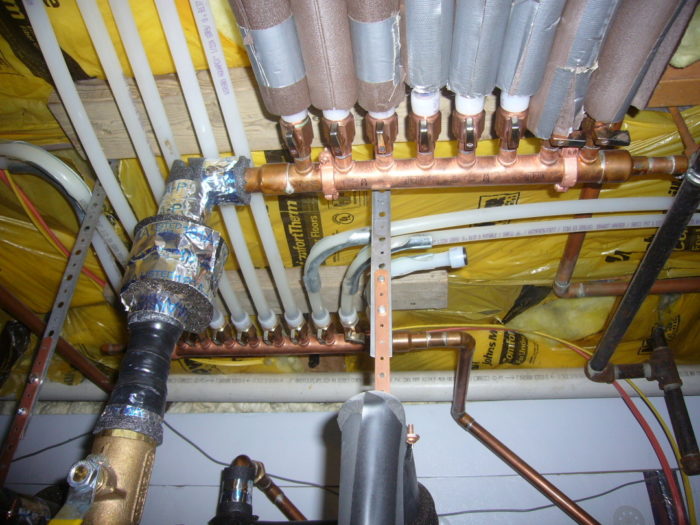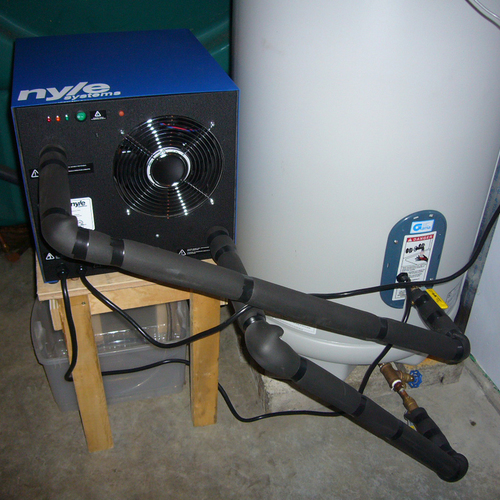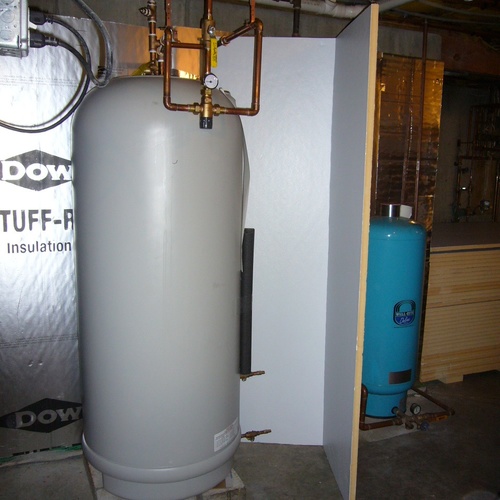
Image Credit: Marc Rosenbaum
In a previous blog, I described our decision to get rid of our oil-fired boiler. When our oil boiler went away, the hot water tank did also, and this gave me an opportunity to relocate the new water heater directly below the two bathrooms. This reduces the wait time to get hot water to the tap substantially, and the tank is now only half the distance from the kitchen as well.
When hot water leaves the tank, it goes through a Caleffi thermostatic mixing valve (TMV). I installed this in case I decide to install a solar hot water system, because solar can make very hot water that carries a scalding risk. A TMV is set to a maximum discharge temperature, which it holds regardless of the inlet temperature. The TMV creates this mixed temperature by mixing hot water from the tank with cold water.
Colleagues of mine have found that some TMVs, even when set at maximum temperature, still mix in some cold water. I tested the Caleffi and it doesn’t do this, which is a nice feature in a solar hot water system — when the water temperature gets right down to the minimum usable temperature you don’t want cold water mixed in, because that will cause the back-up heat to come on.
Manifolds for home-run PEX tubing
Once the mixed water leaves the TMV, it goes to the distribution system. The domestic hot water (DHW) distribution system in our house is a home-run system. There is a manifold for the hot water (and one for the cold water) that has a series of connections with shut-off valves, and each connection has a cross-linked polyethylene (PEX) tubing run that goes to an individual fixture.
In my house, these are 1/2-inch lines, but if I were to do this myself from scratch they would be 3/8 inch for most fixtures. One of the advantages of a home-run system is usually shorter wait times for hot water than occurs with a traditional trunk-and-branch system. The smaller the tubing, the faster hot water gets to your tap. Having a shut-off valve for each fixture allows an individual fixture to be repaired or replaced without having to lose the function of any other fixture.
The photo at the top of the page shows the manifolds above the DHW tank; the cold manifold is behind the hot one.
A recirculation pump for the hot water line
Another efficient approach to getting hot water quickly to each fixture while wasting minimal water is to use an intermittently operating recirculation pump (for examples, the Taco D’Mand). My very smart colleague Gary Klein has written extensively about the benefits of one of these systems.
Here’s a simple schematic he drew of one:
Notice that the hot water line continues back to the DHW tank after the last fixture branch. When you are in the bathroom, you push a button (it can also be set up with a motion detector, to work automatically) and the pump turns on, sending hot water to you at several gallons per minute. When it reaches the pump, the pump turns off, and you have hot water in a very short time, and almost no water went down the drain while you waited. If the water in the line is already hot from a recent draw, the pump doesn’t come on.
This clever system is a variation on the old continuous recirculation systems that waste both thermal energy (because the recirc loop is always hot) and electricity (because the pump runs all the time.)
Modified home-run systems
The larger and more spread out a house is, the more benefit from this type of system. It really makes sense to look at each house and evaluate the best approach.
My colleague Michael Chandler suggests that a modified home-run system, which has a single 1/2-inch line running to each bathroom and a 3/8-inch branch for each fixture, is often the best way to go, at least for a modest-sized home. That approach means that once someone uses hot water in the sink, for example, there is hot water available for the shower or second sink with no waiting.
Marc Rosenbaum is director of engineering at South Mountain Company on the island of Martha’s Vineyard in Massachusetts. He writes a blog called Thriving on Low Carbon.
Weekly Newsletter
Get building science and energy efficiency advice, plus special offers, in your inbox.
















7 Comments
Short ripe runs & tank insulation
I'm wondering if someone can comment on the efficiency gained from reducing the pipe length from the hot water tank to the fixtures. In the house I've recently purchased, I have inherited an electric hot water tank that may have replaced a gas unit because it's next to the chimney but it's at the opposite end of the house (30') from all of our hot water users (bathroom, kitchen and laundry) I'm planning to move the tank, but other than wasting the 15 seconds of cold water, am I likely to notice any energy savings by doing this?
Also applicable to this hot water discussion is how much insulation around an electric hot water tank is reasonable? I have installed a foil tank wrap and 2 inches of XPS under the tank, but I wonder if it's worthwhile to add additional insulation?
Thanks for the help!
Response to Mark Fredericks
Mark,
You wrote, "other than wasting the 15 seconds of cold water..."
First of all, the water in your hot-water pipe that sits idle in your basement until it cools off used to be hot water. So when you waste that water, you are actually wasting hot water, not cold water. You paid to heat all that water up, remember?
So, you are wasting the energy used to heat the water. And you are also wasting the water -- which, in areas of the planet subject to drought, is irresponsible (and perhaps even adds to your water bill).
The way to save is to use the
The way to save is to use the cold water more. Nothing else ever would save more than the cost. Water still today hot or cold is very very inexpensive!!@
Any other thoughts is nonsense.
1/2 inch or 3/8
Marc, just wondering if you could expand on why you would install 3/8 on most fixtures if you were doing it yourself. Because then you go on to exlpain how the hot water will get there faster with smaller tubing. Is this just a volume issue, like filling the tub faster?
3/8 lines
Yes, it is the volume and the most efficient system would be home runs with 1/2" lines to bathtubs and hose bibs and 3/8" to everything else and insulate them all. However, some plumbing codes will not allow home runs of 3/8" and you are forced to use 1/2" everywhere.
Motion trigger
"(it can also be set up with a motion detector, to work automatically"
I have seen some references here on GBA about triggering the hot water recirculator based on motion - but in my searches - haven't seen a residential product to do this. Anyone know of a product that will do this - without an EE degree?
Response to Adam W
Adam,
https://www.brazix.com/BRAZIX/en/infrared-motion-sensor-wall-switch?gclid=Cj0KEQjwrte4BRD-oYi3y5_AhZ4BEiQAzIFxnx8eq_dGp_gNWqPR64VBWAUlpj0JWHuxwY8BaQwTrc8aAiTR8P8HAQ
Log in or create an account to post a comment.
Sign up Log in